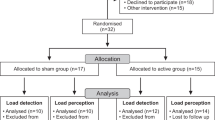Abstract
This study evaluated the effectiveness of a respiratory resistance biofeedback training. Fifteen adult asthmatic subjects participated in a feedback training program including twelve feedback sessions (three sessions weekly). Respiratory resistance (R os) was measured using the forced oscillation method; to prevent subjects from lung hyperinflation, feedback was interrupted when functional residual capacity increased. One-second forced expiratory volume (FEV 1 ), usage of self-administered medication, degree of asthmatic dyspnoea, and general activity were daily recorded in symptom diaries for at least three months, starting four weeks before the first feedback session. Seven subjects showed significant averageR os decreases within the sessions, while meanR os in two subjects was increased. However, these direct feedback effects were not related to transfer effects outside the laboratory: e.g., not one of the seven successful subjects showed FEV1 improvements, and only in one of them were within-sessionR os reductions accompanied by a decreased frequency of self-administered medication during the training period. These results lead to the conclusion thatR os feedback may not be an effective technique for the treatment of bronchial asthma in adults.
Similar content being viewed by others
References
Box, G. E. P., & Jenkins, G. M. (1976).Time series analysis. Forecasting and control (2nd edition). San Francisco: Holden-Day.
Briscoe, W. A., & DuBois, A. B. (1958). The relationship between airway resistance, airway conductance and lung volume in subjects of different age and body size.Journal of Clinical Investigation, 37 1279–1285.
Comroe, J. H. (1977).Physiology of respiration (2nd edition). Chicago: Year Book Medical Publishers.
Comroe, J. H., Forster, R. E., DuBois, A. B., Briscoe, W. A., & Carlsen, E. (1977).The lung. Clinical physiology and pulmonary function tests. Chicago: Year Book Medical Publishers.
Dixon, W. J. (Ed.) (1983).BMDP statistical software. Berkeley: University of California Press.
DuBois, A. B., Brody, A. W., Lewis, D. H., & Burgess, B. F. (1956). Oscillation mechanics of lung and chest in man.Journal of Applied Physiology, 8 587–594.
Erskine-Milliss, J. M., & Cleary, P. J. (1987). Respiratory resistance feedback in the treatment of bronchial asthma in adults.Journal of Psychosomatic Research, 31 765–775.
Feldman, G. M. (1976). The effect of biofeedback training on respiratory resistance of asthmatic children.Psychosomatic Medicine, 38 27–34.
Franetzki, M., Prestele, K., & Korn, V. (1979). A direct-display oscillation method for measurement of respiratory impedance.Journal of Applied Physiology, 46 956–965.
Janson-Bjerklie, S., & Clarke, E. (1982). The effects of biofeedback training on bronchial diameter in asthma.Heart and Lung, 11 371–375.
Leplow, B., Kramer, C., Dahme, B., & Richter, R. (1986). Biofeedback-Training des Atemwiderstandes. In V. Sill (Ed.),Kongressbericht der 19. Wissenschaftlichen Tagung der Norddeutschen Gesellschaft für Lungen- und Bronchialheilkunde (pp. 183–190). Frankfurt a. M.: Universimed-Verlag.
Levenson, R. W. (1974). Automated system for direct measurement and feedback of total respiratory resistance by the forced oscillation technique.Psychophysiology, 11 86–90.
Mass, R., Harden, H., Leplow, B., Wessel, M., Richter, R., & Dahme, B. (1991). A device for functional residual capacity controlled biofeedback of respiratory resistance.Biomedizinische Technik—Biomedical Engineering, 36 78–85.
Schafmeister, A., Richter, R., Andresen, B., & Thom, E. (1981). Methodological study to predict the spirometric volume curve and parameters of the breathing cycle from thoracic and abdominal girth changes.Biological Psychology, 16 294–295.
Steptoe, A., Phillips, J., & Harling, J. (1981). Biofeedback and instructions in the modification of total respiratory resistance: an experimental study on asthmatic and non-asthmatic volunteers.Journal of Psychosomatic Research, 25 541–551.
Vachon, L., & Rich, E. S. (1976). Visceral learning in asthma.Psychosomatic Medicine, 38 122–130.
Author information
Authors and Affiliations
Additional information
The authors thank Dr. Christian Haasen for grammatical correction of the manuscript. This work was supported by a grant from the German Research Society, SPP 166 “Interoception and Behavior Control,” Project Ri 448/1.
Rights and permissions
About this article
Cite this article
Mass, R., Dahme, B. & Richter, R. Clinical evaluation of a respiratory resistance biofeedback training. Biofeedback and Self-Regulation 18, 211–223 (1993). https://doi.org/10.1007/BF00999080
Issue Date:
DOI: https://doi.org/10.1007/BF00999080




